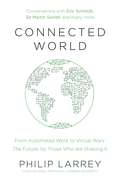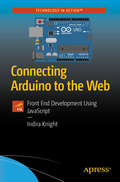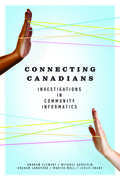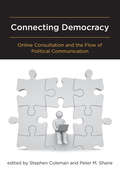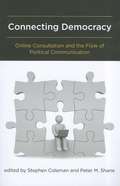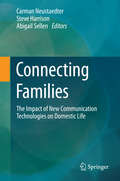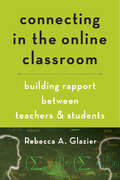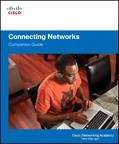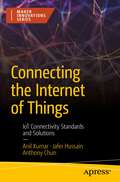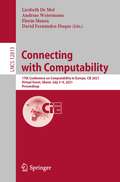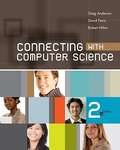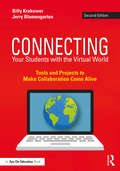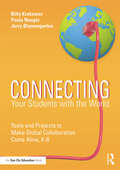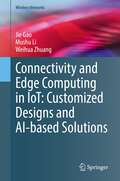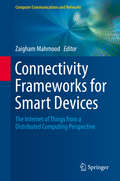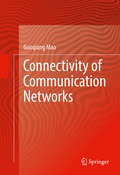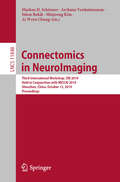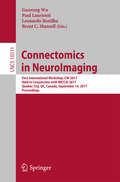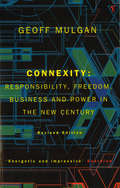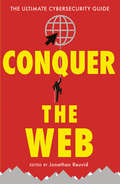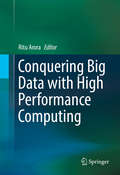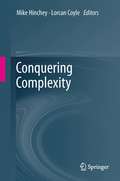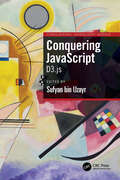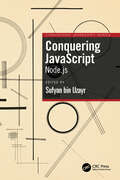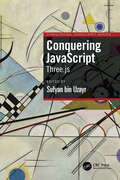- Table View
- List View
Connected World: From Automated Work to Virtual Wars: The Future, By Those Who Are Shaping It
by Father Philip LarreyThe world as we know it is changing. Driverless cars, drone deliveries and autonomous weapon systems are no longer the stuff of science fiction.But what's next for technology and business, and how will it impact our society?In Connected World, Philip Larrey of the Pontifical Lateran University explores the consequences of the new digital age in conversation with leaders including Sir Martin Sorrell, CEO of WPP, Eric Schmidt, CEO of Google's parent company Alphabet, and Maurice Lévy, CEO of Publicis Groupe.Ranging from the death of privacy to the rise of artificial intelligence, Connected World asks the existential questions which will come to define our age.
Connecting Arduino to the Web: Front End Development Using JavaScript
by Indira KnightCreate physical interfaces that interact with the Internet and web pages. With Arduino and JavaScript you can create interactive physical displays and connected devices that send data to or receive data from the web. You'll take advantage of the processes needed to set up electronic components, collect data, and create web pages able to interact with electronic components.Through exercises, projects, and explanations, this book will give you the core front end web development and electronics skills needed to create connected physical interfaces and build compelling visualizations with a range of JavaScript libraries.By the end of the book you will have developed fully working interactive prototypes capable of sending data to and receiving data from a physical interface. Most importantly, Connecting Arduino to the Web will give you a taste of what is possible and the knowledge to create your own connected physical interfaces and bring the web into your electronics projects.What You'll LearnBuild an Internet of Things dashboard that updates with electronics attached to an ArduinoUse components to interact with online 3D displaysCreate web pages with HTML and CSSSet up a Node.js serverUse WebSockets to process live dataInteract with scalable vector graphics (SVG)Who This Book Is ForTechnologists, developers, and enthusiasts looking to extend their skills, be able to develop physical prototypes with connected devices, and with an interest in getting started with IoT. Also, those excited by the possibilities of connecting the physical and the web.
Connecting Canadians: Investigations in Community Informatics
by Andrew Clement Michael Gurstein Graham Longford Marita Moll Leslie Regan ShadeConnecting Canadians represents the work of the Community Research Alliance for Community Innovation and Networking (CRACIN), the largest national and international research effort to examine the burgeoning field of community informatics, a cross-disciplinary approach to the mobilization of information and communications technologies (ICT) for community change. Funded for four years by the SSHRC's Initiative for the New Economy, CRACIN systematically studied a wide variety of Canadian community ICT initiatives, bringing perspectives from sociology, computer science, critical theory, women's studies, library and information sciences, and management studies to bear on networking technologies. A comprehensive thematic account of this in-depth research, Connecting Canadians will be an essential resource for NGOs, governments, the private sector, and multilateral agencies across the globe.
Connecting Democracy: Online Consultation and the Flow of Political Communication (The\mit Press Ser.)
by Stephen Coleman Peter M. ShaneAn investigation of the effect of government online forums on democratic practices in the United States and Europe.The global explosion of online activity is steadily transforming the relationship between government and the public. The first wave of change, “e-government,” enlisted the Internet to improve management and the delivery of services. More recently, “e-democracy” has aimed to enhance democracy itself using digital information and communication technology. One notable example of e-democratic practice is the government-sponsored (or government-authorized) online forum for public input on policymaking. This book investigates these “online consultations” and their effect on democratic practice in the United States and Europe, examining the potential of Internet-enabled policy forums to enrich democratic citizenship.The book first situates the online consultation phenomenon in a conceptual framework that takes into account the contemporary media environment and the flow of political communication; then offers a multifaceted look at the experience of online consultation participants in the United States, the United Kingdom, and France; and finally explores the legal architecture of U.S. and E. U. online consultation. As the contributors make clear, online consultations are not simply dialogues between citizens and government but constitute networked communications involving citizens, government, technicians, civil society organizations, and the media. The topics examined are especially relevant today, in light of the Obama administration's innovations in online citizen involvement.
Connecting Democracy
by Stephen Coleman Peter M. ShaneThe global explosion of online activity is steadily transforming the relationship between government and the public. The first wave of change, "e-government," enlisted the Internet to improve management and the delivery of services. More recently, "e-democracy" has aimed to enhance democracy itself using digital information and communication technology. One notable example of e-democratic practice is the government-sponsored (or government-authorized) online forum for public input on policymaking. This book investigates these "online consultations" and their effect on democratic practice in the United States and Europe, examining the potential of Internet-enabled policy forums to enrich democratic citizenship. The book first situates the online consultation phenomenon in a conceptual framework that takes into account the contemporary media environment and the flow of political communication; then offers a multifaceted look at the experience of online consultation participants in the United States, the United Kingdom, and France; and finally explores the legal architecture of U. S. and E. U. online consultation. As the contributors make clear, online consultations are not simply dialogues between citizens and government but constitute networked communications involving citizens, government, technicians, civil society organizations, and the media. The topics examined are especially relevant today, in light of the Obama administration's innovations in online citizen involvement.
Connecting Families: The Impact of New Communication Technologies on Domestic Life (Computer Supported Cooperative Work Ser.)
by Carman Neustaedter Steve Harrison Abigail SellenNew technologies are radically changing the way that families connect with one another: we can text our teenagers from work, eat dinner with far-away parents via video link, and instantly upload and share photos after a family day out. Whether we are bridging time or distance, and whether we are enhancing our closest relationships or strengthening the bonds of extended family, as computer technologies alter the communication landscape, they in turn are changing the way we conduct and experience family life. This state of the art volume explores the impact of new communication systems on how families interact - how they share their lives and routines, engage in social touch, and negotiate being together or being apart - by considering a range of different family relationships that shape the nature of communication. Composed of three sections, the first looks at what is often the core of a 'family', the couple, to understand the impact of technology on couple relationships, communication, and feelings of closeness. The second section studies immediate families that have expanded beyond just the individual or couple to include children. Here, the emphasis is on connection for communication, coordination, and play. The third section moves beyond the immediate family to explore connections between extended, distributed family members. This includes connections between adult children and their parents, grandparents and grandchildren, and adult siblings. Here family members have grown older, moved away from 'home', and forged new families. Researchers, designers and developers of new communication technologies will find this volume invaluable. Connecting Families: The Impact of New Communication Technologies on Domestic Life brings together the most up-to-date studies to help in understanding how new communication technologies shape - and are shaped by - family life, and offers inspiration and guidance for design by making clear what families need and value from technological systems.
Connecting in the Online Classroom: Building Rapport between Teachers and Students
by Rebecca A. GlazierBuilding rapport with students can revive the promise of online education, leading to greater success for students, more fulfilling teaching experiences for faculty, and improved enrollment for universities.More students than ever before are taking online classes, yet higher education is facing an online retention crisis; students are failing and dropping out of online classes at dramatically higher rates than face-to-face classes. Grounded in academic research, original surveys, and experimental studies, Connecting in the Online Classroom demonstrates how connecting with students in online classes through even simple rapport-building efforts can significantly improve retention rates and help students succeed. Drawing on more than a dozen years of experience teaching and researching online, Rebecca Glazier provides practical, easy-to-use techniques that online instructors can implement right away to begin building rapport with their students, including • proactively reaching out through personalized check-in emails;• creating opportunities for human connection before courses even begin through a short welcome survey;• communicating faculty investment in students' success by providing individualized and meaningful assignment feedback;• hosting non-content-based discussion threads where students and faculty can get to know one other; and• responding to students' questions with positivity and encouragement (and occasionally also cute animal pictures).She also presents case studies of universities that are already using these strategies, along with specific, data-driven recommendations for administrators, making the book valuable for faculty, instructional designers, support staff, and administrators alike. The science-backed strategies that Glazier provides will enable instructors to connect with their students and help those students thrive. Speaking to the paradox of online learning, the book also explains that, although the great promise of online education is expanded access and greater equity—especially for traditionally underserved and hard-to-reach populations, like lower-income students, working parents, first-generation students, and students of color—the current gap between online and face-to-face retention means universities are falling far short of this promise.
Connecting Networks Companion Guide
by Cisco Networking AcademyThis course discusses the WAN technologies and network services required by converged applications in a complex network. The course allows you to understand the selection criteria of network devices and WAN technologies to meet network requirements. You will learn how to configure and troubleshoot network devices and resolve common issues with data link protocols. You will also develop the knowledge and skills needed to implement IPSec and virtual private network (VPN) operations in a complex network.
Connecting the Internet of Things: IoT Connectivity Standards and Solutions
by Anil Kumar Jafer Hussain Anthony ChunNavigating the fragmented IoT connectivity ecosystem of standards, protocols, and architectures can be a challenge. Not to mention scaling a solution to a viable product. This book guides you through this fractured landscape with real world examples and projects that can be leverage for an IoT product. Backed by an overview of IoT use cases and key connectivity elements of IoT solutions, you'll gain an understanding of the breadth of the IoT landscape and the fragmentation of connectivity standards and solutions and the challenge in navigating the many standards and technologies. You'll also be able to understand the essentials of connectivity including, hardware, software, and business models. IoT is essential for increasing productivity of many industries and quality of life (making the world smart and autonomous). Both wired and wireless connectivity technologies are essential ingredients in an IoT product. Written by Intel engineers and architects, Connecting the Internet of Things understands that connectivity is a key topic of IoT and comprehensively covers the topic from a system engineering and practical perspective.What You'll LearnUnderstand the trade offs between different wireless technologies and network topologiesUse wireless technologies in IoT productsExamine connectivity technologies and considerations on selecting it for the IoT use casesAssemble all of the components of a working solution Scale your solution to a productReview emerging connectivity technologies for addressing new use casesAdvance and optimize the performance of existing technologiesWho This Book Is ForResearchers, managers, strategists, technologists, makers, and students in the embedded and Internet of Things (IoT) space trying to understand and implement connectivity in the devices/platforms.
Connecting with Computability: 17th Conference on Computability in Europe, CiE 2021, Virtual Event, Ghent, July 5–9, 2021, Proceedings (Lecture Notes in Computer Science #12813)
by Florin Manea Liesbeth De Mol Andreas Weiermann David Fernández-DuqueThis book constitutes the proceedings of the 17th Conference on Computability in Europe, CiE 2021, organized by the University of Ghent in July 2021. Due to COVID-19 pandemic the conference was held virtually.The 48 full papers presented in this volume were carefully reviewed and selected from 50 submissions. CiE promotes the development of computability-related science, ranging over mathematics, computer science and applications in various natural and engineering sciences, such as physics and biology, as well as related fields, such as philosophy and history of computing. CiE 2021 had as its motto Connecting with Computability, a clear acknowledgement of the connecting and interdisciplinary nature of the conference series which is all the more important in a time where people are more than ever disconnected from one another due to the COVID-19 pandemic.
Connecting with Computing Science
by Greg Anderson David Ferro Robert HiltonWritten for the beginning computing student, this text engages readers by relating core computer science topics to their industry application. The book is written in a comfortable, informal manner, and light humor is used throughout the text to maintain interest and enhance learning. All chapters contain a multitude of exercises, quizzes, and other opportunities for skill application.
Connecting Your Students with the Virtual World: Tools and Projects to Make Collaboration Come Alive
by Billy Krakower Jerry BlumengartenMake the most of today’s technology to give your students a more interactive, authentic, global learning experience! Connecting Your Students with the Virtual World shows you how to plan themed projects for every season, embark on virtual field trips, and get students in touch with other classrooms worldwide. This updated edition includes a key new chapter on taking video conferencing to the next level for optimal student engagement and collaboration, as well as new chapters on connecting through games and esports and connecting with parents. The book includes a wide variety of standards-based, step-by-step activities you can implement immediately.
Connecting Your Students with the World: Tools and Projects to Make Global Collaboration Come Alive, K-8
by Billy Krakower Paula Naugle Jerry BlumengartenMake the most of today’s technology to give your students a more interactive, authentic learning experience! Connecting Your Students with the World shows you how to use web tools to get K–8 students in touch with other classrooms worldwide. This book is a valuable resource to help you find and communicate with other teachers and classrooms and even design your own collaborative online projects. You’ll find out how to: Conduct videoconferencing calls to put your students in touch with classrooms around the world; Embark on Virtual Field Trips; Plan themed projects for every season, including fun holiday activities; And more! The book includes detailed instructions for each activity and connections to the Common Core, ISTE, and Next Generation Science Standards, so you can ensure that you are meeting your state’s requirements as you prepare your students to become engaged, informed, and global citizens. Additionally, a comprehensive list of online resources is available as a free download from the Routledge website at www.routledge.com/9781138902961.
Connectivity and Edge Computing in IoT: Customized Designs and AI-based Solutions (Wireless Networks)
by Jie Gao Mushu Li Weihua ZhuangThis book covers connectivity and edge computing solutions for representative Internet of Things (IoT) use cases, including industrial IoT, rural IoT, Internet of Vehicles (IoV), and mobile virtual reality (VR). Based on their unique characteristics and requirements, customized solutions are designed with targets such as supporting massive connections or seamless mobility and achieving low latency or high energy efficiency. Meanwhile, the book highlights the role of artificial intelligence (AI) in future IoT networks and showcases AI-based connectivity and edge computing solutions. The solutions presented in this book serve the overall purpose of facilitating an increasingly connected and intelligent world. The potential benefits of the solutions include increased productivity in factories, improved connectivity in rural areas, enhanced safety for vehicles, and enriched entertainment experiences for mobile users. Featuring state-of-the-art research in the IoT field, this book can help answer the question of how to connect billions of diverse devices and enable seamless data collection and processing in future IoT. The content also provides insights regarding the significance of customizing use case-specific solutions as well as approaches of using various AI methods to empower IoT. This book targets researchers and graduate students working in the areas of electrical engineering, computing engineering, and computer science as a secondary textbook or reference. Professionals in industry who work in the field of IoT will also find this book useful.
Connectivity Frameworks for Smart Devices: The Internet of Things from a Distributed Computing Perspective (Computer Communications and Networks)
by Zaigham MahmoodThis timely volume provides a review of the state-of-the-art frameworks and methodologies for connecting diverse objects and devices according to the vision for an Internet of Things (IoT). A specific focus is placed on the communication, security, and privacy aspects of device connectivity in distributed environments. Insights and case studies are provided by an authoritative selection of contributors of international repute into the latest research advances and practical approaches with respect to the connectivity of heterogeneous smart and sensory devices. Topics and features: Examines aspects of device connectivity within the IoT Presents a resource-based architecture for IoT, and proposes a resource management framework for corporate device clouds Reviews integration approaches for the IoT environment, and discusses performance optimization of intelligent home networks Introduces a novel solution for interoperable data management in multi-clouds, and suggests an approach that addresses the debate over network neutrality in the IoT Describes issues of data security, privacy, access control, and authentication in the distributed IoT environment Reviews the evolution of VANETs in relation to the Internet of Vehicles, and provides a perspective on developing smart sustainable cities This invaluable text/reference will be of great benefit to a broad audience, from students and researchers interested in the IoT vision, to practicing communication engineers and network security specialists.
Connectivity of Communication Networks
by Guoqiang MaoThis book introduces a number of recent developments on connectivity of communication networks, ranging from connectivity of large static networks and connectivity of highly dynamic networks to connectivity of small to medium sized networks. This book also introduces some applications of connectivity studies in network optimization, in network localization, and in estimating distances between nodes. The book starts with an overview of the fundamental concepts, models, tools, and methodologies used for connectivity studies. The rest of the chapters are divided into four parts: connectivity of large static networks, connectivity of highly dynamic networks, connectivity of small to medium sized networks, and applications of connectivity studies.
Connectomics in NeuroImaging: Third International Workshop, CNI 2019, Held in Conjunction with MICCAI 2019, Shenzhen, China, October 13, 2019, Proceedings (Lecture Notes in Computer Science #11848)
by Markus D. Schirmer Archana Venkataraman Islem Rekik Minjeong Kim Ai Wern ChungThis book constitutes the refereed proceedings of the Third International Workshop on Connectomics in NeuroImaging, CNI 2019, held in conjunction with MICCAI 2019 in Shenzhen, China, in October 2019.The 13 full papers presented were carefully reviewed and selected from 14 submissions. The papers deal with new advancements in network construction, analysis, and visualization techniques in connectomics and their use in clinical diagnosis and group comparison studies as well as in various neuroimaging applications.
Connectomics in NeuroImaging: First International Workshop, CNI 2017, Held in Conjunction with MICCAI 2017, Quebec City, QC, Canada, September 14, 2017, Proceedings (Lecture Notes in Computer Science #10511)
by Guorong Wu Brent C. Munsell Paul Laurienti Leonardo BonilhaThis book constitutes the refereed proceedings of the First International Workshop on Connectomics in NeuroImaging, CNI 2017, held in conjunction with MICCAI 2017 in Quebec City, Canada, in September 2017. The 19 full papers presented were carefully reviewed and selected from 26 submissions. The papers deal with new advancements in network construction, analysis, and visualization techniques in connectomics and their use in clinical diagnosis and group comparison studies as well as in various neuroimaging applications.
Connexity: How to Live in a Connected World
by Geoff MulganCONNEXITY is the philosophical counterpart to Will Hutton's essentially political book. It looks at the profound tension that exists between two recent achievements of humanity: greater freedom (over how to live, who to love, what to believe and say, where to trade), and greater interdependence, or 'connexity' (through the financial markets, military structures, the internet, the ecosystem). This tension has led to crisis: institutions, including governments, sense themselves to be inadequate; individuals are faced with a mass of conflicting information and values. The issue we face, which will ultimately determine human survival in our densely packed planet, is how the tension between these two can be resolved, and a new order established. Mulgan presents his own powerful solution to this crisis. It is based around the notion of 'connexity': breaking down our rigid sense of ourselves as isolated units and seeing our lives as part of a system, a positive network of co-responsibility.
Conquer the Web: The Ultimate Cybersecurity Guide
by Nick Ioannou Maureen Kendal Tim Mitchell Nick Wilding Jonathan ReuvidTons of malicious content floods the internet which can compromise your system and your device, be it your laptop, tablet or phone. <P><P> How often do you make payments online? Do you have children and want to ensure they stay safe online? How often do you sit at a coffee shop and log onto their free WIFI? How often do you use social media on the train or bus? If you believe using an antivirus software will keep devices safe... you are wrong. This book will guide you and provide solutions to avoid common mistakes and to combat cyber attacks. This Guide covers areas such as: <P><P> Building resilience into our IT Lifestyle Online Identity Cyber Abuse: Scenarios and Stories Protecting Devices Download and share Gaming, gamble and travel Copycat websites I Spy and QR Codes Banking, apps and Passwords
Conquering Big Data with High Performance Computing
by Ritu AroraThis book provides an overview of the resources and research projects that are bringing Big Data and High Performance Computing (HPC) on converging tracks. It demystifies Big Data and HPC for the reader by covering the primary resources, middleware, applications, and tools that enable the usage of HPC platforms for Big Data management and processing. Through interesting use-cases from traditional and non-traditional HPC domains, the book highlights the most critical challenges related to Big Data processing and management, and shows ways to mitigate them using HPC resources. Unlike most books on Big Data, it covers a variety of alternatives to Hadoop, and explains the differences between HPC platforms and Hadoop. Written by professionals and researchers in a range of departments and fields, this book is designed for anyone studying Big Data and its future directions. Those studying HPC will also find the content valuable.
Conquering Complexity
by Mike Hinchey Lorcan CoyleSoftware has long been perceived as complex, at least within Software Engineering circles. We have been living in a recognised state of crisis since the first NATO Software Engineering conference in 1968. Time and again we have been proven unable to engineer reliable software as easily/cheaply as we imagined. Cost overruns and expensive failures are the norm. The problem is fundamentally one of complexity: software is fundamentally complex because it must be precise. Problems that appear to be specified quite easily in plain language become far more complex when written in a more formal notation, such as computer code. Comparisons with other engineering disciplines are deceptive. One cannot easily increase the factor of safety of software in the same way that one could in building a steel structure, for example. Software is typically built assuming perfection, often without adequate safety nets in case the unthinkable happens. In such circumstances it should not be surprising to find out that (seemingly) minor errors have the potential to cause entire software systems to collapse. The goal of this book is to uncover techniques that will aid in overcoming complexity and enable us to produce reliable, dependable computer systems that will operate as intended, and yet are produced on-time, in budget, and are evolvable, both over time and at run time. We hope that the contributions in this book will aid in understanding the nature of software complexity and provide guidance for the control or avoidance of complexity in the engineering of complex software systems.
Conquering JavaScript: D3.js (Conquering JavaScript)
by Sufyan Bin UzayrJavaScript has become the de facto standard when it comes to both web and cross-platform development. D3.js is an extremely popular JS framework, meant for rapid web and application development. Conquering JavaScript: D3.js helps the reader master the D3.js framework for faster and more robust development. This book is a detailed guide that will help developers and coders do more with D3.js. It discusses the basics in brief, and then moves on to more advanced and detailed exercises to help readers quickly gain the required knowledge. Key Features: Provides industry-specific case-based examples. Discusses visual implementation of D3.js for project work. Emphasizes how to write clean and maintainable code. This book is a valuable reference for D3.js developers as well as those involved in game development, mobile apps, progressive applications, and now even desktop apps.
Conquering JavaScript: Node.js (Conquering JavaScript)
by Sufyan Bin UzayrJavaScript is without a question among the most prominent and commonly used client-side programming languages available. JavaScript's scope of use has expanded in recent years, and it is now also used for server-side development. Node.js is an extremely popular JS framework, meant for rapid web and application development. Conquering JavaScript: Node.js helps the reader master the Node.js framework for faster and more robust development. This book is a detailed guide that will help developers and coders do more with Node.js. It discusses the basics in brief, and then moves on to more advanced and detailed exercises to help readers quickly gain the required knowledge. Key Features: Discusses how to use Node.js for real-world practical solutions Provides complete coverage of full-stack development Covers server-side development with Node.js This book is a valuable reference for Node.js developers as well as those involved in game development, mobile apps, progressive applications, and now even desktop apps.
Conquering JavaScript: Three.js (Conquering JavaScript)
by Sufyan Bin UzayrHave you ever considered how these visuals and games are shown in a web browser? What technology is at the heart of it? Of course, employing HTML and CSS alone will not be sufficient. Three.js is a free JavaScript toolkit for displaying images, 3D, and 2D objects in web browsers that enables you to render graphics and 3D objects on a canvas in the web browser using your GPU (Graphics Processing Unit). Conquering JavaScript: Three.js helps the reader master the Three.js framework for faster and robust development. The book is a detailed guide that will help developers and coders do more with Three.js. It covers the basics in brief, and then moves on to more advanced and detailed exercises to help readers quickly gain the required knowledge. Key Features: Examines JavaScript specific content, with emphasis on graphics libraries Discusses using Three.js for animated graphic creation Provides code optimization tips and solutions This book is a valuable reference for Three.js developers as well as those involved in game development, mobile apps, progressive applications, and now even desktop apps.
